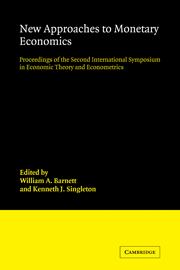 New Approaches to Monetary Economics
New Approaches to Monetary Economics Published online by Cambridge University Press: 04 August 2010
Introduction
A predominant focus of macroeconomic research in the last ten years has been on the origins of the business cycle. In particular, it has been popular to view the business cycle as arising from surprise movements in aggregate demand and to argue that these impulses are transmitted to real activity through movements in the price level. In order to generate empirically relevant fluctuations, however, such models must incorporate mechanisms to propagate price surprises over time. That is, to replicate economic fluctuations, it is necessary to transform serially uncorrelated price surprises into serially correlated macroeconomic time series. Unfortunately, despite the large amount of effort devoted in recent years to this type of equilibrium business cycle modeling, relatively little attention has been focused on isolating the empirically important propagation mechanisms.
More recently, we have pursued a line of research that we call “real business cycle theory,” in which disturbances are propagated over time as a result both of economic agents' desire to smooth commodity profiles and capitalistic production with rich intertemporal substitution opportunities. To date, however, these models incorporate only real supplyside or technological disturbances, abstracting from real demand-side influences (such as government spending) or nominal shocks. Nevertheless, the results on propagation mechanisms appear to be relevant for more fully developing the monetary theories of business fluctuation discussed above.
Of course, interest in propagation mechanisms is not new. Indeed, it was the major focus of many of the interwar business cycle theorists.
To save this book to your Kindle, first ensure [email protected] is added to your Approved Personal Document E-mail List under your Personal Document Settings on the Manage Your Content and Devices page of your Amazon account. Then enter the ‘name’ part of your Kindle email address below. Find out more about saving to your Kindle.
Note you can select to save to either the @free.kindle.com or @kindle.com variations. ‘@free.kindle.com’ emails are free but can only be saved to your device when it is connected to wi-fi. ‘@kindle.com’ emails can be delivered even when you are not connected to wi-fi, but note that service fees apply.
Find out more about the Kindle Personal Document Service.
To save content items to your account, please confirm that you agree to abide by our usage policies. If this is the first time you use this feature, you will be asked to authorise Cambridge Core to connect with your account. Find out more about saving content to Dropbox.
To save content items to your account, please confirm that you agree to abide by our usage policies. If this is the first time you use this feature, you will be asked to authorise Cambridge Core to connect with your account. Find out more about saving content to Google Drive.